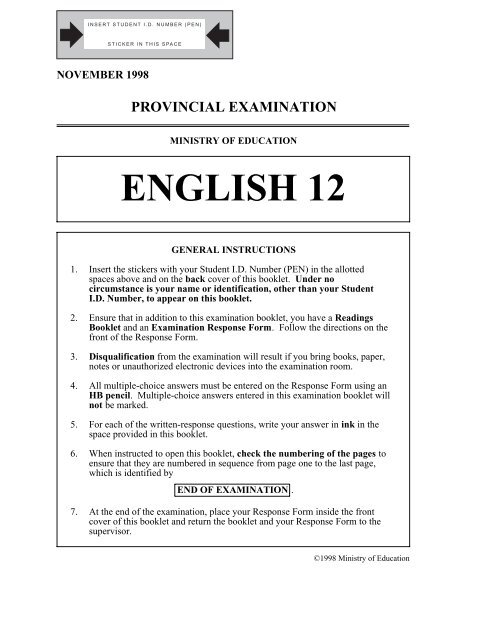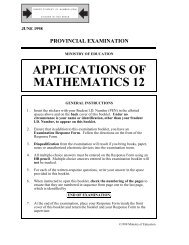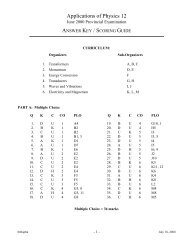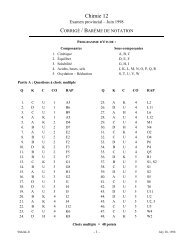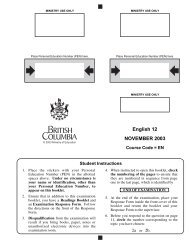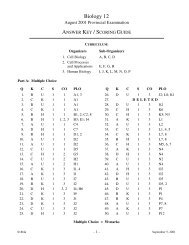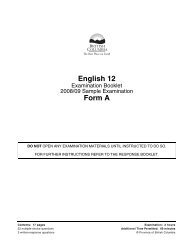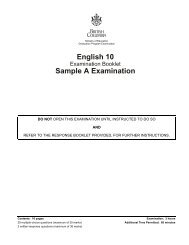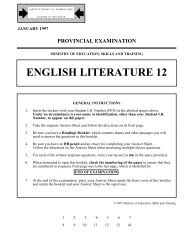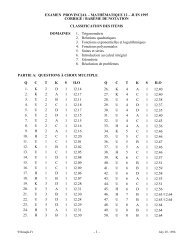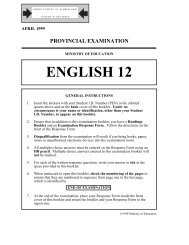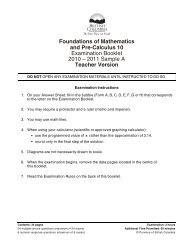ENGLISH 12 - QuestionBank.CA
ENGLISH 12 - QuestionBank.CA
ENGLISH 12 - QuestionBank.CA
Create successful ePaper yourself
Turn your PDF publications into a flip-book with our unique Google optimized e-Paper software.
INSERT STUDENT I.D. NUMBER (PEN)STICKER IN THIS SPACENOVEMBER 1998PROVINCIAL EXAMINATIONMINISTRY OF EDU<strong>CA</strong>TION<strong>ENGLISH</strong> <strong>12</strong>GENERAL INSTRUCTIONS1. Insert the stickers with your Student I.D. Number (PEN) in the allottedspaces above and on the back cover of this booklet. Under nocircumstance is your name or identification, other than your StudentI.D. Number, to appear on this booklet.2. Ensure that in addition to this examination booklet, you have a ReadingsBooklet and an Examination Response Form. Follow the directions on thefront of the Response Form.3. Disqualification from the examination will result if you bring books, paper,notes or unauthorized electronic devices into the examination room.4. All multiple-choice answers must be entered on the Response Form using anHB pencil. Multiple-choice answers entered in this examination booklet willnot be marked.5. For each of the written-response questions, write your answer in ink in thespace provided in this booklet.6. When instructed to open this booklet, check the numbering of the pages toensure that they are numbered in sequence from page one to the last page,which is identified byEND OF EXAMINATION .7. At the end of the examination, place your Response Form inside the frontcover of this booklet and return the booklet and your Response Form to thesupervisor.©1998 Ministry of Education
THIS PAGE INTENTIONALLY BLANK
<strong>ENGLISH</strong> <strong>12</strong> PROVINCIAL EXAMINATIONValueSuggestedTime1. This examination consists of five parts:PART A: Editing Skills 10 10PART B: Reading Comprehension 21 35PART C: Poetry 20 30PART D: Prose 25 50PART E: Composition 24 55Total: 100 marks 180 minutes2. Electronic devices, including dictionaries and pagers, are not permitted in the examinationroom.3. The Readings Booklet contains the prose and poetry passages you will need to answer certainquestions on this examination.4. The time allotted for this examination is three hours. Use your time wisely. Adequate writingspace has been provided for average-sized writing. Do not attempt to determine the length ofyour answers by the amount of writing space available.- 1 -OVER
PART A: EDITING SKILLSTotal Value: 10 marksSuggested Time: 10 minutesINSTRUCTIONS:The following passage has been divided into numbered sentences which maycontain problems in grammar, usage, word choice, spelling, or punctuation. One ormore sentences may be correct. No sentence contains more than one error.If you find an error, select the underlined part that must be changed in order to makethe sentence correct and record your choice on the Response Form provided. Usingan HB pencil, completely fill in the circle that corresponds to your answer. If thereis no error, completely fill in circle D (no error).AIR TRAVEL IN BRITISH COLUMBIA1. The airline system in British Columbia, which extends from Victoria to(A)Fort Nelson, is definitely one of Canadas most comprehensive airline services.(B)(C)(D) no error2. The province is currently served by two major airlines, each with its own excellent(A)service and safety record, their ticket prices are also comparable.(B)(C)(D) no error3. One of the airlines even provide a heli-jet service from Vancouver to Victoria(A)for those business customers in need of a quick flight.(B)(C)(D) no error4. Both airlines also offer reliable “medi-vac” service for British Columbians needing(A)(B)emergency medical treatment and to fly them to Vancouver if necessary.(C)(D) no error- 2 -
5. Although some airports do not have lighted runways, most regions(A)are accessible at all times during the day or night irregardless of weather conditions.(B)(C)(D) no error6. Because the airlines also have a variety of aircraft available. One can fly safely(A)(B)almost anywhere in relative comfort.(C)(D) no error7. Tourists flying anywhere over the province cannot help but be effected by the(A)(B)spectacular landscape they see below them.(C)(D) no error8. According to pilot Pat Kelly, “Flying in BC is a scenic experience. Soaring over(A)(B)the mountains with their snowcapped peaks is always a treat I look forward to.”(C)(D) no error9. Those frequent flyers who experience some turbulence during winter flights(A)realize its something that is part of flying in mountainous terrain.(B)(C)(D) no error10. The airlines currently provide the province with a very satisfactory(A)service, moreover, they continue to improve their schedules each year.(B)(C)(D) no error- 3 -OVER
PART B: READING COMPREHENSIONTotal Value: 21 marksSuggested Time: 35 minutesINSTRUCTIONS:Read “Bugs of Wonder” on pages 1 to 3 in the Readings Booklet. For eachquestion, select the best answer and record your choice on the Response Formprovided.11. As used in paragraph 2, the word “resilience” means the power toA. resist heat.B. spread out.C. reside quietly.D. recover strength.<strong>12</strong>. Because of the new discovery, the name “Dead Sea” in paragraph 5 could now be consideredA. ironic.B. historic.C. sarcastic.D. simplistic.13. Paragraph 7 suggests thatA. microbes were discovered in an earthquake.B. the microbes are affecting the roots of the tree.C. new discoveries are being made about microbes.D. there is evidence of microbes originating in space.14. In paragraphs 14 and 15, Patrick Dennis, the biochemist, indicates thatA. microbes are plentiful.B. microbes are invisible.C. polar bears are important.D. spotted owls are nearly extinct.15. According to paragraph 17, which of the following are found in only the top layer of the sea?A. fungiB. archaeaC. bacteriaD. phytoplankton- 4 -
16. In paragraph 22, the word “innocuous” meansA. foreign.B. harmless.C. minuscule.D. dangerous.17. According to paragraph 31, one reason why microbes may prove to be helpful in industrialprocesses is that they canA. change their shape.B. hold molecules apart.C. build chemical bridges.D. survive high temperatures.18. The hypothesis implied in paragraph 34 is that microbesA. are meteorites.B. have come from space.C. are used as biochemical tools.D. are used by extraterrestrial life.19. Which of the following paragraphs best expresses the main idea of the entire passage?A. paragraph 23B. paragraph 24C. paragraph 27D. paragraph 2920. The style of language used in this passage is primarily QUESTION DELETEDA. formal.B. archaic.C. informal.D. regional slang.21. The title of the passage suggests that microbes areA. curious.B. surprising.C. widespread.D. supernatural.- 5 -OVER
Bugs of Wonder(pages 1 to 3 in the Readings Booklet)INSTRUCTIONS:Use the space provided in this booklet for written-response questions. Write youranswers in ink. You may quote or paraphrase. Complete sentences are notrequired in this section.1. From paragraphs 9 to 11, list four ways in which microbes contributed to the shaping of theplanet.a)(1 mark)b)(1 mark)c)(1 mark)d)(1 mark)2. In paragraph 14, Dennis refers to polar bears and spotted owls as “bit players” compared tomicrobes. From paragraphs 14 to 19, give two reasons that support this idea.a)(1 mark)b)(1 mark)- 6 -
3. From paragraphs 22 to 27, list two similarities and two differences that exist between archaeaand bacteria.Similarity 1:(1 mark)Similarity 2:(1 mark)Difference 1:(1 mark)Difference 2:(1 mark)- 7 -OVER
Total Value: 20 marksPART C: POETRYSuggested Time: 30 minutesINSTRUCTIONS:Read the poem “Snowy Owl After Midnight” on pages 4 and 5 in the ReadingsBooklet. For each question, select the best answer and record your choice on theResponse Form provided.22. In line 21, the words “privy to a ritual strange” suggest the speaker isA. resented by the owl.B. searching for solitude.C. allowed into the owl’s world.D. seeking peaceful surroundings.23. Line 23, “now I’m not so sure,” suggestsA. the owl followed the speaker.B. animals are watching the speaker.C. the speaker doubts the owl was hunting.D. the speaker doubts the wildness of the owl.24. Lines 25 to 27, “he wings above my shoulder / quick and small as those moons / we watched inchildhood,” contain an example ofA. irony.B. simile.C. repetition.D. end rhyme.25. Line 29, “those moons that always raced us home,” contains an example ofA. paradox.B. oxymoron.C. synecdoche.D. personification.26. In line 43, the words “Under these drumming wings” contain an example ofA. alliteration.B. dissonance.C. apostrophe.D. onomatopoeia.- 8 -
27. In line 45, the words “my clipped, pale hands” suggestA. a contrast to the owl’s talons.B. the speaker fears the owl’s talons.C. a comparison of hunters’ weapons.D. the speaker intends to hurt the owl.28. In line 55, the words “your vigil burns white fire in the trees” contain an example ofA. allusion.B. metaphor.C. hyperbole.D. understatement.29. The attitude of the speaker towards the owl isA. hostile.B. fearful.C. mocking.D. respectful.- 9 -OVER
Snowy Owl After Midnight(pages 4 and 5 in the Readings Booklet)INSTRUCTIONS:In paragraph form, answer questions 4 and 5 in the space provided. Write in ink.The mark for your answer will be based on the appropriateness of the example(s)you use as well as the adequacy of your explanation and the quality of your writtenexpression.4. In paragraph form and with reference to the poem, describe the character that the speakerbelieves the owl to have.(6 marks)- 10 -
5. In paragraph form and with reference to the poem, show that the speaker feels closelyconnected to the owl.(6 marks)- 11 -OVER
Total Value: 25 marksPART D: PROSESuggested Time: 50 minutesINSTRUCTIONS:Read the story entitled “The Bedquilt” on pages 6 to 10 in the Readings Booklet.For each question, select the best answer and record your choice on the ResponseForm provided.30. In paragraph 3, the word “incessantly” meansA. quietly.B. dutifully.C. haltingly.D. continuously.31. In paragraph 7, the phrase “innocent guile” implies that MehetabelA. was afraid of Sophia.B. frequently manipulated Sophia.C. knew when to approach Sophia.D. often experienced Sophia’s temper.32. Aunt Mehetabel accepted the treatment she received from her brother’s family because sheA. had never known any different life.B. resented her position in the household.C. did not realize how poorly they treated her.D. was too shy to have ever wished for a life of her own.33. Paragraph 29 contains the stylistic device ofA. exaggeration.B. understatement.C. run-on sentences.D. parallel structure.34. In paragraph 31, Mehetabel’s words, “I’d be ashamed to tell you what they said” suggest thewomen at the fair wereA. critical.B. envious.C. friendly.D. complimentary.- <strong>12</strong> -
35. Aunt Mehetabel did not look at any other exhibits at the County Fair because she wasA. afraid she would get lost.B. unwilling to leave her quilt.C. too shy to meet other people.D. too tired to walk to the other exhibits.36. The point of view of this story isA. objective.B. omniscient.C. first person.D. limited omniscient.- 13 -OVER
The Bedquilt(pages 6 to 10 in the Readings Booklet)INSTRUCTIONS:In paragraph form, answer questions 6 to 8 in the space provided. Write in ink.The mark for your answer will be based on the appropriateness of the example(s)you use as well as the adequacy of your explanation and the quality of your writtenexpression.6. In paragraph form and with reference to the story, discuss Mehetabel’s character. (6 marks)- 14 -
7. In paragraph form and with reference to the story, trace the change of attitude of familymembers towards Mehetabel.(6 marks)- 15 -OVER
8. In paragraph form and with reference to the story, discuss the quilt as a symbol in the story.(6 marks)- 16 -
Total Value: 24 marksPART E: COMPOSITIONSuggested Time: 55 minutesINSTRUCTIONS:Using standard English, write a coherent, unified, multi-paragraph composition of300-500 words on the topic below. In your composition, you may apply anyeffective and appropriate method of development which includes any combinationof exposition, persuasion, description, and narration.Use the page headed Organization and Planning for your rough work. Write yourcomposition in ink on the pages headed Finished Work.9. Write a multi-paragraph composition on the topic below. Your response may draw upon anyaspect of your life: your reading, your own experiences, the experiences of others, and so on.Topic: Uncertainty- 17 -OVER
Organization and Planning- 18 -
FINISHED WORK- 20 -
FINISHED WORK- 21 -OVER
FINISHED WORKEND OF EXAMINATION1stSUBTOTAL2nd- 22 -
||||||||||||||||||||||||||||||||||||||||||||||||||||||||||||
INSERT STUDENT I.D. NUMBER (PEN)STICKER IN THIS SPACE<strong>ENGLISH</strong> <strong>12</strong>November 1998Course Code = EN
FOR OFFICE USE ONLY<strong>ENGLISH</strong> <strong>12</strong>November 1998Course Code = ENScore forQuestion 1:1. _____(4)Score forQuestion 2:2. _____(2)Score forQuestion 3:3. _____(4)Score forQuestion 8:8. _____(6)Score forQuestion 9:9. _____(24)Score forQuestion 4:4. _____(6)Score forQuestion 5:5. _____(6)Score forQuestion 6:6. _____(6)Score forQuestion 7:7. _____(6)
<strong>ENGLISH</strong> <strong>12</strong>READINGS BOOKLETNOVEMBER 1998©1998 Ministry of Education
THIS PAGE INTENTIONALLY BLANK
PART B: READING COMPREHENSIONINSTRUCTIONS:Read the following passage and answer the questions on pages 4 to 7 of theexamination booklet.Adapted from Bugs of Wonderby Margaret Munro1 One lives in a solution so salty it would make you gag. Another thrives at temperatures hotenough to kill most other living things. “They’re perfectly happy,” says biochemist PatrickDennis of the microbes in a toasty 80-degree Celsius vat in his University of BC lab.2 The heat-loving microscopic organisms, like their salt-loving cousins in a flask down the hall, aresome of the stranger members of the ever-expanding microbial family that is shaking up long-heldassumptions about life, its origin and its resilience.3 “We’re starting to see microbes in places that are just unbelievable,” says UBC microbiologistBob Hancock, rattling off some of the improbable locales. “They seem to defy just abouteverything we know about life.”4 Tiny organisms have been found laying down gold deposits in South America; surviving on a dietof basalt rock several kilometres underground in Sweden; residing in scalding deep-sea vents offthe BC and Washington coast; living on frigid rocks in the Antarctic.5 They’ve “put the lie” to the name of the Dead Sea, which scientists now realize can teem withinvisible life. Microbes may even be growing on distant planets, according to geophysicistsstudying tantalizing signs of life on a meteorite from Mars.6 It’s possible—but impossible to prove without a better extraterrestrial sample—that life on Earthstarted when contaminated dust or rock dropped in from space. Such microscopic aliens may,according to evolutionary biologists, have planted the microbial seeds that over the eons branchedinto the tree of life found on Earth today.7 Even without such space invaders, the tree has recently been shaken to its roots.8 A vast family of new microorganisms, which has been named archaea, has been found living ineverything from the backyard garden to the deep sea floor. Archaea are so different from bacteriathat biologists have decided they deserve their own branch on the tree of life.9 Scientists are also realizing just how critical a role microbes played in shaping the planet: theygave the atmosphere its oxygen two billion years ago; they were critical to the formation of thebiosphere; they helped shape many energy and mineral deposits by concentrating everything fromgold to oil.10 A Canadian team has concluded that microbial handiwork laid down the famed Serra Pelada goldfield in the Amazon jungle. The scientists say the rich lode—more than 100 tonnes—wasproduced not by the accepted mechanisms of ore formation but by swarms of microbes that overmillions of years concentrated the gold from jungle soils and rivers and rocks.- 1 -OVER
11 Researchers are also digging up piles of evidence—such as deposits packed with strings of tinycrystals that microbes strung together like tiny diamonds—that microorganisms helped lay downmany of the world deposits of carbonates, phosphates, oxides and sulphides.<strong>12</strong> “It is really very obvious there is a strong link between geoscience and microbiology,” saysHojatollah Vali, a bio-mineralization specialist at McGill University and a member of the NASAteam that analysed signs of microbial life on the Mars meteorite earlier this year.13 As biologists like to point out, the life that’s invisible to the naked eye remains one of the mostimportant forms of life on the planet.14 Polar bears and spotted owls may be environmental darlings. But as UBC’s Dennis puts it,they’re “bit players.” It’s microbes that dominate life on earth.15 Though incredibly small, he notes that they’re also incredibly common.16 “They’re everywhere,” says Dennis.17 Each millilitre of sea water contains as many as 10 million single-celled organisms. Up to half ofthem may belong to the recently discovered microbial family, archaea. Unlike phytoplankton thatlive on in the sea’s top layer, archaea and bacteria are found from the top to the bottom of the sea.18 This is why some scientists—Dennis among them—figure microbes are the most common formof life on the planet.19 “They’re major players in terms of biomass,” Dennis says. “Yet we have relatively littleunderstanding of what they’re doing.”20 “They’re turning out to be far more diverse and complex than we expected,” adds Rosie Redfield,a UBC microbiologist who, like Dennis, is part of the evolutionary biology team put together bythe Canadian Institute for Advanced Research.21 “We know so little about the biology around us,” says Redfield, who marvels over the wayknowledge about microbes is “just exploding.”22 Until recently most bacteria and archaea have been ignored because they’re as innocuous as theyare ubiquitous: they don’t cause disease and death. Most are difficult to grow in a laboratory.23 “Only one per cent of the microbes found in sea water will grow in culture,” Dennis says.24 The recent discovery of microbes in so many unexpected places, coupled with the advent of geneanalysingtechniques, has enabled scientists to realize how diverse the microbial world is.25 Archaea, for example, look like run-of-the-mill bacteria under the microscope. In fact, scientiststhought for years they were bacteria. Only after genetic inspection did scientists realize they werea distinct breed of life.26 Archaea employ very different and more sophisticated biochemical processes than bacteria do,and followed an evolutionary path all their own. To get a better read on what sets them apart,Dennis’s UBC team has been breaking down two strains of archaea to molecular pieces.- 2 -
27 One thrives in a high-salt environment that would literally suck life out of other life forms. Thesemicrobes occur around the world in salt ponds and other high-salt environments, including theDead Sea. They’ve even been found inside salt crystals in British salt mines.28 The other microbe they are dissecting is a heat-lover known as sulfolobus. It is common in hotsprings, geysers and deep-sea vents, where temperatures can hit 350 degrees Celsius.29 The UBC work is part of an international research effort to define the chemical tricks themicrobes use to survive in extreme environments.30 Powerful chemical bridges are built into the microbes’ proteins to hold the molecules together.This allows the proteins, which include enzymes and other chemical workhorses, to maintain theirshape and function in heat and salt that would destroy the flimsier proteins common to othermicrobes.31 There are plenty of practical applications for the tough molecules. Some enzymes from heatlovingarchaea have already been put to work in genetic engineering machines, where they copyand splice together genetic molecules. And they may prove valuable in industrial processes thatrequire high heat.32 There is speculation that organisms in the archaea family are the closest remaining descendants ofEarth’s earliest life forms. That is because so many of the microbes thrive in extremeenvironments that might have been common when primordial stew swirled around the planet.33 Dennis says recent speculation that microbes lived on Mars once again raises the possibility thatlife on Earth was seeded from space. It’s clear from biochemicals found in everything fromarchaea to humans that all life on Earth shares common ancestors: proteins, genes and nucleicacid on Earth all use the same building blocks. And life on other planets could use the samechemicals. But without an extraterrestrial sample, the question will remain unanswered.34 While the scientists have used every possible tool at their disposal to prove the meteorite wasonce inhabited by Martian microbes, Vali says the evidence remains suggestive but inconclusive.“We don’t have the proof yet.”- 3 -OVER
PART C: POETRYINSTRUCTIONS:Read the following poem and answer the questions on pages 8 to 11 of theexamination booklet.Snowy Owl After Midnightby Tim Bowling151015202530I like to believe he waits for mein the dark pines along the river,eyes trained on the porchlightof my house;I like to believe his blood stirsat my presence, in a way unknownto him, but that he also understandsthe heightened smell of joy and fearmy bones give offas I shut the door behind meand plunge into the stars.It is so quiet at this hour,just the two of us awake,each hunting in his waythe small gifts of the night,what he seeks in the long grassand marshes, what I seekin the soft, unpeopled silence:at first I thought I followed himalong the dyke and through the fields,privy to a ritual strange andwild in its solitude;now I’m not so sure.For mileshe wings above my shoulderquick and small as those moonswe watched in childhoodfrom the backseats of our parents’ cars,those moons that always raced us home,that we could never lose- 4 -
3540455055and when I stop, he’s there,settling on a fence-post or piling,diving behind a clump of trees;never a shriek from the grassnever a word from my throat;we have circled each other’s silencethis way for months.Again, tonight, I wonderwhat he would tell me if he could;would he say the blood that calls himto the earth is a bloodhe does not understand?Under these drumming wings I wonderwhat death does he expectmy clipped, pale hands to make?I would say to him now,this blank page riffling in the night,this beating heart of a snowmanextant from some boyish dream,brother, I have stopped my ears againstthe blood that calls me to the earthbut I will move here with youin its dark and silent flowingas long as breath is givenand your vigil burns white fire in the trees.- 5 -OVER
PART D: PROSEINSTRUCTIONS:Read the following selection and answer the questions on pages <strong>12</strong> to 16 of theexamination booklet.Adapted from The Bedquiltby Dorothy Canfield Fisher1 Of all the Elwell family Aunt Mehetabel was certainly the most unimportant member. It was in theold-time New England days, when an unmarried woman was an old maid at twenty, at forty waseveryone’s servant, and at sixty had gone through so much discipline that she could need no more inthe next world. Aunt Mehetabel was sixty-eight.2 She had never for a moment known the pleasure of being important to anyone. Not that she wasuseless in her brother’s family; she was expected, as a matter of course, to take upon herself the mosttedious and uninteresting part of the household labours. On Mondays she accepted as her share thewashing of the men’s shirts, heavy with sweat and stiff with dirt from the fields and from their ownhardworking bodies. Tuesdays she never dreamed of being allowed to iron anything pretty or eveninteresting, like the baby’s white dresses or the fancy aprons of her young lady nieces. She stood allday pressing out a monotonous succession of dish cloths and towels and sheets.3 In preserving-time she was allowed to have none of the pleasant responsibility of deciding when thefruit had cooked long enough, nor did she share in the little excitement of pouring the sweetsmellingstuff into stone jars. She sat in a corner with the children and stoned cherries incessantly,or hulled strawberries until her fingers were dyed red.4 The Elwells were not consciously unkind to their aunt, they were even in a vague way fond of her;but she was so insignificant a figure in their lives that she was almost invisible to them. AuntMehetabel did not resent this treatment; she took it quite as unconsciously as they gave it. Shegathered what crumbs of comfort she could from their occasional careless kindnesses and tried tohide the hurt which, even yet, pierced her at her brother’s rough joking.5 Her sister-in law, a big hearty housewife, who ruled indoors with as autocratic a sway as did herhusband on the farm, was rather kind in an absent, offhand way to the shrunken little old woman,and it was through her that Mehetabel was able to enjoy the one pleasure of her life. Even as a girlshe had been clever with her needle in the way of patching bedquilts. During years of devotion tothis one art she had accumulated a considerable store of quilting patterns. Sometimes the neighbourswould send over and ask “Miss Mehetabel” for the loan of her sheaf-of-wheat design, or the doublestarpattern.6 She never knew how her great idea came to her. Sometimes she thought she must have dreamed it,sometimes she even wondered reverently, in the phraseology of the weekly prayer meeting, if it hadnot been “sent” to her. She never admitted to herself that she could have thought of it without otherhelp. It was too great, too ambitious, too lofty a project for her humble mind to have conceived.Even when she finished drawing the design with her own fingers, she gazed at it incredulously, notdaring to believe that it could indeed be her handiwork. At first it seemed to her only like a lovelybut unreal dream. For a long time she did not once think of putting an actual quilt togetherfollowing that pattern, even though she herself had invented it.- 6 -
7 She dared do nothing in the household where she was a dependent, without asking permission. Witha heart full of hope and fear thumping furiously against her old ribs, she approached the mistress ofthe house on churning-day, knowing with the innocent guile of a child that the countrywoman wasapt to be in a good temper while working over the fragrant butter in the cool cellar.8 Sophia listened absently to her sister-in-law’s halting petition. “Why, yes, Mehetabel,” she said,“start another quilt if you want to. I’ve got a lot of pieces from the spring sewing that will work inreal good.” Mehetabel tried honestly to make her see that this would be no common quilt. At lastSophia said, with a kindly impatience: “Oh, there! Don’t bother me. I never could keep track ofyour quiltin’ patterns, anyhow. I don’t care what pattern you go by.”9 Mehetabel rushed back up the steep attic stairs to her room, and in a joyful agitation beganpreparations for the work of her life. Her very first stitches showed her that it was even better thanshe hoped. By some heaven-sent inspiration she had invented a pattern beyond which no patchworkquilt could go.10 She had but little time during the daylight hours filled with the incessant household drudgery. Afterdark she did not dare to sit up late at night lest she burn too much candle. It was weeks before thelittle square began to show the pattern.11 Every time she opened the door, no matter what weather hung outside the small window, she alwayssaw the little room flooded with sunshine. She smiled to herself as she bent over the innumerablescraps of cotton cloth on her work table. Already—to her—they were arranged in orderly, complex,mosaic-beauty.<strong>12</strong> Finally she could wait no longer, and one evening ventured to bring her work down beside the firewhere the family sat. As she stood, the square fell from her trembling old hands and fluttered to thetable. Sophia glanced at it carelessly. “Is that the new quilt you said you wanted to start?” sheasked, yawning. “Looks like a real pretty pattern. Let’s see it.”13 “Land’s sakes!” cried her sister-in-law. “Why, Mehetabel Elwell, where did you git that pattern?”14 “I made it up,” said Mehetabel. She spoke quietly but she was trembling.15 “No!” exclaimed Sophia. “Did you! Why, I never did see such a pattern in my life. Girls, comehere and see what your Aunt Mehetabel is doing.”16 The girls looked at it right side, wrong side, and echoed their mother’s exclamations. Mr. Elwellhimself came over to see what they were discussing. “Well, I declare!” he said, looking at his sisterwith eyes more approving than she could ever remember. “I don’t know a thing about patchworkquilts, but to my eye that beats old Mis’ Andrew’s quilt that got the blue ribbon so many times at theCounty Fair.”17 As she lay that night in her narrow hard bed, too proud, too excited to sleep, Mehetabel’s heartswelled and tears of joy ran down from her old eyes.18 The next day her sister-in-law astonished her by taking the huge pan of potatoes out of her lap andsetting one of the younger children to peeling them. “Don’t you want to go on with that quiltin’pattern?” she said. “I’d kind o’ like to see how you’re goin’ to make the grapevine design come outon the corner.”- 7 -OVER
19 For the first time in her life the dependent old maid contradicted her powerful sister-in-law. Quicklyand jealously she said, “It’s not a grapevine. It’s a sort of curlicue I made up.”20 “Well, it’s nice looking anyhow,” said Sophia pacifyingly. “I never could have made it up.”21 By the end of the summer the family interest had risen so high that Mehetabel was given for herselfa little round table in the sitting room, for her, where she could keep her pieces and use odd minutesfor her work. She almost wept over such kindness and resolved firmly not to take advantage of it.She went on faithfully with her monotonous housework, not neglecting a corner. But theatmosphere of her world was changed. Now things had a meaning. Through the longest task ofwashing milk-pans, there rose a rainbow of promise.22 A year went by and a quarter of the quilt was finished. A second year passed and half was done.The third year Mehetabel had pneumonia and lay ill for weeks and weeks, horrified by the idea thatshe might die before her work was completed. A fourth year and one could really see the grandeurof the whole design. In September of the fifth year, the entire family gathered around her to watcheagerly, as Mehetabel quilted the last stitches. The girls held it up by the four corners and they alllooked at it in hushed silence.23 Then Mr. Elwell cried as one speaking with authority, “By ginger! That’s goin’ to the County Fair!”24 Even in her pride Mehetabel felt a pang as the bulky package was carried out of the house. As thedays went on she felt lost. For years it had been her one thought. The little round stand had beenheaped with a litter of bright-coloured scraps. Now it was desolately bare. She drooped. Thefamily noticed it. One day Sophia said kindly, “You feel sort o’ lost without the quilt, don’t youMehetabel?25 “They took it away so quick!” she said wistfully. “I hadn’t hardly had one good look at it myself.”26 The fair was to last a fortnight. At the beginning of the second week Mr. Elwell asked his sister howearly she could get up in the morning.27 “I dunno. Why?” she asked.28 “Well, Thomas Ralston has got to drive to West Oldton to see a lawyer. That’s four miles beyondthe Fair. He says if you can git up so’s to leave here at four in the morning he’ll drive you to theFair, leave you there for the day, and bring you back again at night.” Mehetabel’s face turned verywhite. Her eyes filled with tears. It was as though someone had offered her a ride in a goldenchariot up to the gates of heaven. “Why, you can’t mean it!” she cried wildly. Her brother laughed.He could not meet her eyes. Even to his easy-going unimaginative indifference to his sister this wasa revelation of the narrowness of her life in his home. “Oh, ’tain’t so much—just to go to the Fair,”he told her in some confusion, and then “Yes, sure I mean it. Go git your things ready, for it’stomorrow morning he wants to start.”29 A trembling, excited old woman stared all that night at the rafters. She who had never been morethan six miles from home—it was to her like going into another world. She who had never seenanything more exciting than a church supper was to see the County Fair. She who had neverdreamed of doing it. She could not at all imagine what it would be like.- 8 -
30 The next morning all the family rose early to see her off. The buggy drove up to the door, and shewas helped in. The family ran to and fro with blankets, woolen tippet, a hot soapstone from thekitchen range. Her wraps were tucked about her. They all stood together and waved goodbye as shedrove out of the yard. She waved back, but she scarcely saw them. On her return home that eveningshe was ashy pale, and so stiff that her brother had to lift her out bodily. But her lips were set in ablissful smile. They crowded around her with questions until Sophia pushed them all aside. Shetold them Aunt Mehetabel was too tired to speak until she had had her supper. The young peopleheld their tongues while she drank her tea, and absentmindedly ate a scrap of toast with an egg.Then the old woman was helped into an easy chair before the fire. They gathered around her, eagerfor news of the great world, and Sophia said, “Now, come, Mehetabel, tell us all about it!”31 Mehetabel drew a long breath. “It was just perfect!” she said. “Finer even than I thought. They’vegot it hanging up in the very middle of a sort o’ closet made of glass, and one of the lower corners isripped and turned back so’s to show the seams on the wrong side. There are a whole lot of otherones in that room, but not one that can hold a candle to it. I heard lots of people say the same thing.You ought to have heard what the women said about that corner, Sophia. They said—well, I’d beashamed to tell you what they said. I declare if I wouldn’t!”32 Mr. Elwell asked, “What did you think of that big ox we’ve heard so much about?”33 “I didn’t look at the stock,” returned his sister indifferently. She turned to one of her nieces. “Thatset of pieces you gave me, Maria, from your red waist, come out just lovely! I heard one woman sayyou could ’most smell the red roses.”34 “How did Jed Burgess’ bay horse place in the mile trot?” asked Thomas.35 “I didn’t see the races.”36 “How about the preserves?” asked Sophia.37 “I didn’t see the preserves,” said Mehetabel calmly.38 Seeing that they were gazing at her with astonished faces she went on, to give them a reasonableexplanation, “You see, I went right to the room where the quilt was, and then I didn’t want to leaveit. It had been so long since I’d seen it. I had to look at it first real good myself, and then I looked atthe others to see if there was any that could come up to it. Then the people begun comin’ in and Igot so interested in hearin’ what they had to say I couldn’t think of goin’ anywheres else. I ate mylunch right there too, and I’m glad as can be I did, too; for what do you think?”—she gazed abouther with kindling eyes. “While I stood there with a sandwich in one hand, didn’t the head of thewhole concern come in and open the glass door and pin a big bow of blue ribbon right in the middleof the quilt with a label on it, ‘First Prize’.”39 There was a stir of proud congratulation. Then Sophia returned to questioning, “Didn’t you go tosee anything else?”40 “Why, no,” said Mehetabel. “Only the quilt. Why should I?”- 9 -OVER
41 She fell into a reverie. As if it hung again before her eyes she saw the glory that shone around thecreation of her hand and brain. She longed to make her listeners share the golden vision with her.She struggled for words. She fumbled blindly for unknown superlatives. “I tell you it lookedlike—” she began, and paused.42 Vague recollections of hymnbook phrases came into her mind. They were the only kind of poeticexpression she knew. But they were dismissed as being sacrilegious to use for something in reallife. Also as not being nearly striking enough.43 Finally, “I tell you it looked real good,” she assured them and sat staring into the fire, on her tiredold face the supreme content of an artist who has realized her ideal.- 10 -
ACKNOWLEDGEMENTSBowling, Tim. “Snowy Owl After Midnight.” Breathing Fire: Canada’s New Poets.eds. Lorna Crozier and Patrick Lane. Harbour Publishing: Madeira Park, B.C. 1995.Munro, Margaret. “Bugs of Wonder.” The Weekend Sun. Saturday Review.October 19, 1996.Fisher, Dorothy Canfield. “The Bedquilt.” Work and Leisure: The Senior IssuesCollection. ed. Tara J. Fenwick. McGraw-Hill Ryerson Ltd. 1995.- 11 -


